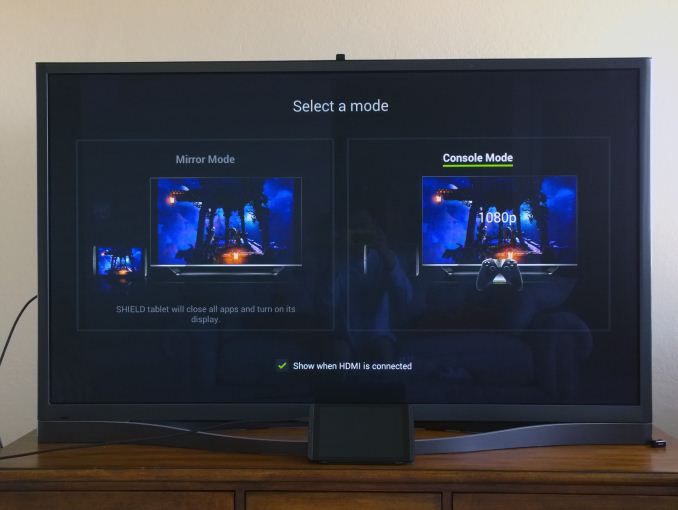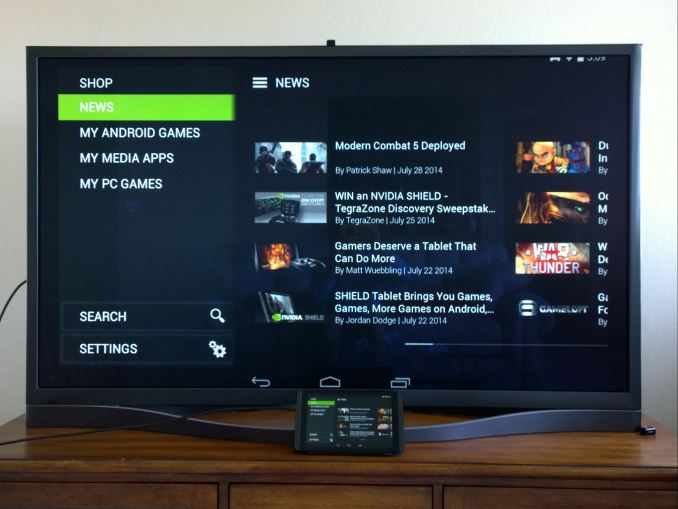The NVIDIA SHIELD Tablet Review
by Joshua Ho on July 29, 2014 9:00 AM ESTSoftware
In the UI department, there’s not too much to talk about. Much like Motorola, NVIDIA has stuck to using the AOSP UI design. Of course, there are plenty of NVIDIA-specific applications, but I didn’t run into any issues using the tablet to do everyday tasks. In this respect, things have improved massively over Shield portable. Because this tablet works in both portrait and landscape, there aren’t any issues with applications that force portrait mode like there were with the Shield portable. In normal tablet usage, it works as one might expect, with no real perceived lag throughout the UI. Of course, this is when compared to other Android devices. There are still frame drops involved in scrolling through lists and similar areas where Android has traditionally struggled to stay smooth, but Android L should fix this issue for the most part.
DirectStylus 2
The real value that the Shield tablet brings as a tablet is the stylus functionality. DirectStylus 2 is definitely much, much better than any other capacitive stylus on the market. The tip allows for precise control and it’s definitely responsive to changes in pressure. For the most part, there are only small issues here. Because the stylus is capacitive, it’s not really possible to have a floating pointer the way Wacom styluses do. In addition, I noticed that I need to lift the stylus a bit more than I might with pencil and paper in order to start a new letter or word or else my words would start to flow together. For the most part though, it works well enough, and the inking latency is low. Unfortunately the issue here is more of ecosystem than hardware, as most stylus-enabled applications aren’t nearly as robust as OneNote on Windows x86.
Console Mode
Of course, the real question here is whether the gaming side is worth the price premium. NVIDIA has gone all out on this area, and their efforts are split up into multiple aspects. The first is the TV interface/console mode, then the gameplay recording feature known as ShadowPlay. Finally, there’s the aspect of GameStream and GRID, which make it possible for games to be played on the tablet that otherwise wouldn’t work due to the compute requirements.
The TV interface effectively boils down to Shield Hub and Google Now, although it’s fully possible to use the full tablet UI as desired in this mode. In the hub, launching games and various applications like YouTube and Netflix is rather simple compared to the more cumbersome full Android UI as they have their own category in Shield Hub. In addition, launching applications through Google Now works as expected. Overall, there aren’t any friction points here. It works as well as one could expect. There is a strong reliance on voice input in general, but it’s much better than trying to type with a controller and better than most smart TV experiences. While the TV interface is mostly targeted towards enabling a console gaming experience, YouTube and Netflix both work great in this mode. NVIDIA has also gone through the necessary DRM certification process to allow for 1080p Netflix streaming. In essence, this device is already ready to serve as an Android TV device.
ShadowPlay
ShadowPlay, which we first saw in GeForce GTX GPUs, is also another major advantage that NVIDIA brings to the table for software experience. In short, this leverages the hardware H.264 video encoder that is on the Tegra K1’s Kepler GPU to provide video capture of gameplay or anything else displayed by the tablet. There are three possible options for video capture. The first is Twitch broadcasting, something that NVIDIA is quite proud of as they are the first to implement such a feature in an Android tablet. While I personally don’t stream on Twitch, a demo of Twitch broadcasting in the initial launch briefing worked without any visible quality issues in either audio or video.
There are two other recording modes. One is a standard start/stop recording feature, but the other is ShadowPlay/Auto Recording. In short, this keeps anywhere from the past minute to 20 minutes in video. This makes it possible to set and forget about the recording feature rather than constantly managing recordings in manual mode. All of these modes can use the tablet’s microphone and front facing camera for commentary purposes as needed. Local recordings seem to have a maximum of 1080p30, and Twitch broadcasts are limited to 720p30.
While those are the technical details, it’s a painless process. All the user has to do is long press the back button on the controller and select what kind of a recording they’d like to do (Twitch, Auto, Manual, Screenshot) and that’s it. I can see significant potential in this area especially if this device takes off as a gaming platform.
















174 Comments
View All Comments
name99 - Tuesday, July 29, 2014 - link
OK. I guess there are situations where that makes sense. Thx.6cef - Tuesday, July 29, 2014 - link
if "closer to 6504k is better", then you should order the graph by the absolute magnitude of the difference between each devices white point and that ideal value.duh.
kyuu - Wednesday, July 30, 2014 - link
+1kae - Wednesday, July 30, 2014 - link
I'll echo the question of a few previous comments... What is the compatibility of the controller with other Android Devices and PC's supporting WiFi Direct? I'm still rocking the Xbox360 Wireless, but if I can ditch the stupid USB dongle and go direct, I'd do it in a heartbeat. Double the function if it also communicates with my N5, and I'm sold.Anyone know? The documentation only talks about how fast WiFi direct is, but not if NVidia is using some proprietary drivers, or if it will work with any device. My hope is the latter.
wintermute000 - Wednesday, July 30, 2014 - link
it always beats me why the big two don't write decent cross platform drivers. Why on earth did Sony not write a good windows and/or android driver for dualshock for example. Easy money (how much can it possibly cost to write a joypad driver) to instantly create a new market.TheJian - Wednesday, July 30, 2014 - link
proprietary, but nvidia is working with google to get it into AndroidL, so should start to work elsewhere soon, if not at least everything shield that comes along and K1 devices etc. A sale is a sale and you're not giving up a lot here, but mapping software (& community profile uploads for mapping to certain games) goes with it so maybe it would be giving away too much.victorson - Wednesday, July 30, 2014 - link
"Although there are some compelling reasons to go with smaller color gamut." Could someone please help out and say what could those reasons be? I'm really curious, always thought there were no such reasons.UpSpin - Wednesday, July 30, 2014 - link
Take a look at the color gamut of white LEDs. You'll see they're blue ones with a phosphor film to produce 'white' light:http://en.wikipedia.org/wiki/Light-emitting_diode#...
However the color reproduction is lacking, especially on cheap white LEDs (the ones you can buy on eBay for example) The more accurate colors you want (high CRI) the more difficult it becomes, they become more expensive and also less efficient. To reproduce all visible colors the best method is to use three separate LEDs, a blue, green and red one. Such a setup is highly inefficient however.
So all NVidia did was using cheap white LEDs to cut costs but also to enhance battery life at the cost of a poor CRI.
theNiZer - Wednesday, July 30, 2014 - link
Great review, very helpfull !cashnmillions - Wednesday, July 30, 2014 - link
Ok so the display isn't phenomenal. Like anyone can really tell the difference between a few pixels. It's an 8" tablet, it doesn't need resolution above 720p to look good. The GPU capabilities are phenomenal, I remember when the Snapdragon and Adreno destroyed the competition about a year ago, this destroys that. I think it's an awesome piece of hardware, I plan to get one, just kind of sucks that the controller is $60. I wonder if I can use an XBOX 360 controller with it like I can on my Nexus 7.